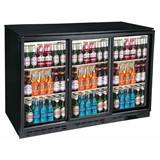Most of us have sat at them, stood at them and crowded around them for a big screen sports event at some stage in our lives. They're as much a part of a bar's personality as music and tap beer and they can make your bar if you get them right. They can also break it if you get them wrong. So here are a few tips to help you buy the right tables for your brand of bar.
It starts with height
Essentially there are four types of bar tables – coffee tables, dining tables, counter-high tables and bar-high tables.
If you're creating intimate bar retreats with couches for groups to lounge on while they chat and drink, perhaps between dances, low coffee tables are the go.
If you're creating a similarly intimate feel with a bar menu that goes beyond nachos and into some serious meals, go for dining tables.
If your serious menu is informal and more diner than dining experience, counter-high tables allow you to sit a lot more punters in relative comfort. Bar-high tables are the real Aussie pub staple that pretty much end up doing everything all the others do plus more besides. With high stools, patrons can sit and talk to those standing.
If the other three options are your more free range, low density bar experience, high tables allow for high density without overly compromising comfort.
Next comes space
Use a scale drawing of your floor plan to place different tables. You'll quickly find that coffee and dining tables tend to take up more space per patron than the other two options. If food isn't a high priority, counter and bar-high options are generally narrower and suited to more intensive seating and standing arrangements.
Another thing you'll notice on your floor plan is the relative space afforded between tables. Ideally you should allow at least a metre or two for reasonable flow of staff. Allow even more around heavy traffic areas – bar, kitchen, exits, and dance floor access points.
Now think about flexibility
And that means deciding if you want fixed tables or movable tables. Movable tables allow you to change your bar configuration for bands, comedy nights, dances and private functions. They also allow you to seat groups together.
On the downside those same groups can decide to move tables themselves blocking aisles for servers. Movable tables are also far more prone to spillage than fixed tables and have a shorter life span. With fixed tables your flexibility is nil, but for many, a familiar bar is a good bar. Fixed tables generally last longer and allow you to really nail down awkward spaces and pillars with built-in tables that maximise their usefulness.









